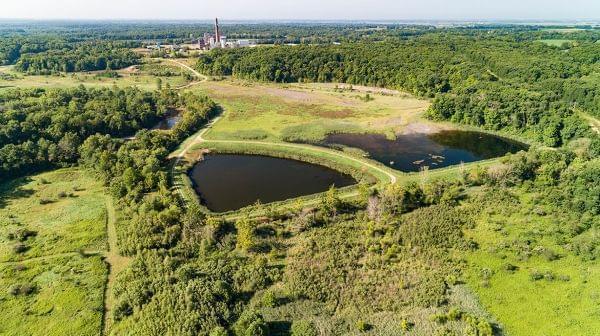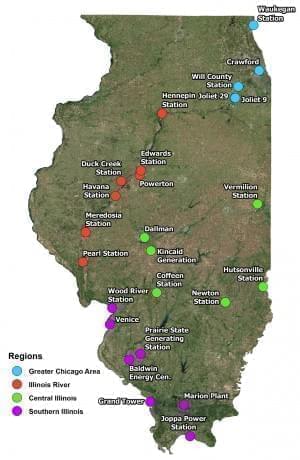Environmental Groups Call For Controls On Coal Ash Dumping

The coal ash ponds at the Vermilion Power Plant are located in the floodplain of the Middle Fork, and sit within feet of the riverbank. . Darrell Hoemann/The Midwest Center for Investigative Reporting
Illinois coal-fired power plants are allowing hazardous coal ash—a byproduct of coal burning—to seep into groundwater and affect the quality of future drinking water. That’s according to a recent report, "Cap and Run," released Wednesday by several environmental advocacy groups that included the Sierra Club, Prairie Rivers Network, Earthjustice, and the Environmental Integrity Project.
Andrew Rehn is a water resources engineer for the Champaign-based Prairie Rivers Network. He said state legislators need to enact stronger rules for permanent protections. Groundwater is a resource that could be used by Illinois residents for drinking in the future, he said. “We should be protecting them."

A map of sites in Illinois with coal ash ponds.
Some power plants across Illinois – from Waukegan to Marion – are closing down their landfill sites, but not giving details about possible cleanups or alternative solutions to long-term storage.
Coal Ash In Vermilion County
One of the facilities cited in the report is the Vermilion Power Station, located near the Middle Fork of the Vermilion River in Vermilion County. The facility, owned by Vistra subsidiary Dynegy, closed in 2011. The report says three unlined coal ash ponds on the power station grounds are “continuously releasing contaminants into the Middle Fork.” Dynegy proposes to leave the coal ash ponds in place, and cap them to keep its contents from leaking out.
But the “Cap And Run” report argues that merely capping the ponds leaves the possibility that the Middle Fork will erode the earthen dikes, and allow toxic ash to tumble into the river, which is the only in Illinois to be designated a National Scenic River.
In a statement issued in September, Vistra Energy Corp. denied that the coal ash ponds at the Vermilion Power Station would post an environmental danger, that that the company was "committed to implementing an effective solution."
Coal Ash In Springfield
In another case cited in the report, Springfield’s City, Water, Light and Power has a coal ash dumping site near the capitol city’s drinking water source. The plant is planning to close the disposal site in the near future.
But the report says CWLP has not provided a closure plan and has not been transparent with residents about possible contamination. “CWLP’s defective monitoring keeps Illinoisans in the dark,” the report stated. The location of the plant’s disposal site could contaminate Sugar Creek and potentially Lake Springfield, the analysis continued.
A spokesperson for CWLP says the report is misleading and that the ash ponds -- as the disposal sites are called -- do not pose a risk to the city's water supply. “CWLP uses appropriate detection monitoring for its ash pond facilities, which are in compliance with regulations, and regularly makes the monitoring data publicly available and posts it on its website,” the statement read.
Possible Legislative Action
Several lawmakers, like state Sen. Scott Bennett of Champaign, say the issue could come up in the General Assembly next year.
“We need a public process that gives communities a say in the decision to close coal ash impoundments," he said. "We need financial guarantees that hold utility companies accountable for cleaning up their waste.”
The ash contains hazardous pollutants like arsenic and lead – all harmful to human health, fish and wildlife, advocates said.
You can read the full report below, or at this link.

